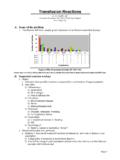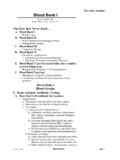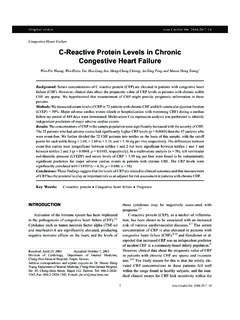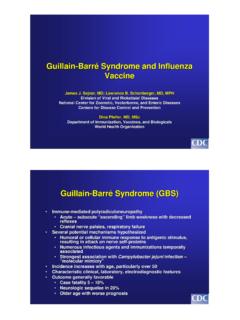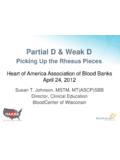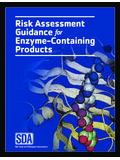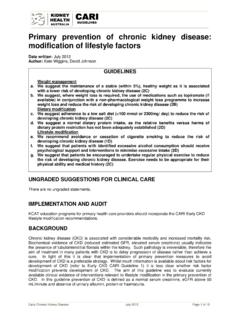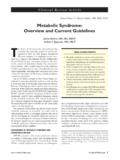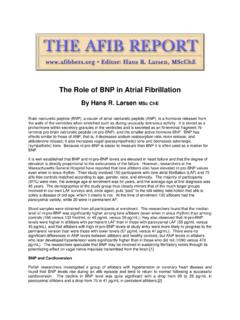Transcription of Pretransfusion Testing (Basic Immunohematology Part 2 ...
1 Pretransfusion Testing (Basic Immunohematology part 2). February 2012. D. Joe Chaffin, MD. I. Outline: A. Overview of Pretransfusion Testing B. Testing methods C. Required components of the process D. Nomenclature of tests used II. Overview A. Purpose 1. Provide a blood component to a patient that will provide maximum benefit while minimizing potential for harm a) Choose the most appropriate blood product from a safe, compatible donor and infuse it into a properly identified and thoroughly tested recipient 2. This requires a systematic process that is fairly rigid 3. Regulated in the US by: a) CLIA (Clinical Laboratory Improvement Amendments, 1988). (1) Determines the minimum standards for lab operations; inspections regulated by Centers for Medicare and Medicaid Services (CMS). (2) Does not often inspect blood banks due to AABB and CAP deemed status (3) Personnel, training, quality control, and proficiency Testing requirements (4) Regulates ABO and D typing, antibody detection, and crossmatching b) AABB (formerly American Association of Blood Banks ).
2 (1) Standards for Blood Banks and Transfusion Services (currently 27th ed). (2) Sets US standard of care for Pretransfusion Testing (3) CLIA deemed status (AABB inspection may be used to satisfy CLIA. inspection requirements in eyes of CMS). c) College of American Pathologists (CAP). (1) Biennial (every 2 yrs) inspection for compliance to laboratory guidelines (2) Major provider of proficiency Testing samples used in nearly all blood banks (3) CLIA deemed status, like AABB. d) FDA. (1) More involved in component collection and manufacturing (2) Specifies which antigens must be present in antibody detection tests B. Map of the process: C. Note that this discussion will be mostly limited to transfusion service actions 1. Pretransfusion Testing Chaffin III. Testing principles (some covered in Blood Groups podcast and handout; December 2011). A. Agglutination 1.
3 Basic reaction in blood banking 2. Two stages: a) Sensitization/coating (1) Binding of antibody to surface of RBCs (2) Dependent on multiple factors (see below). b) Bridge formation (1) Linkage of adjacent RBCs that are coated with antibody (2) IgM is far more capable of forming bridges between adjacent cells due to its pentameric structure (total of 10 possible bridging sites). (3) IgG has a harder time, since it only has two binding regions (a) Antigens that extend from the surface of the RBC, such as M, N and ABO, make it easier for IgG to directly bind and form bridges (b) Rh and other antigens that live closer to the surface of the cell are not usually directly agglutinated by IgG antibodies (see later). 3. Sensitization is simply a chemical reaction a) Antigen + Antibody Antigen-Antibody b) K0 = equilibrium constant of reaction (1) Larger K0 means a push to the right side of the equation, with more stable and rapid reactions c) Affinity of RBC antigens and antibodies affected by multiple factors (1) Cold-reactive (usually IgM) vs.
4 Warm-reactive (usually IgG). (a) Must react in appropriate temperature for best antibody detection i) Cold antibodies are usually vs. carbohydrate antigens (ABO, Lewis, I/i, P, M, N). ii) Warm usually vs. protein antigens (Rh, Kell, Kidd, Duffy, etc.). (b) Warm antibodies most important (except ABO). (2) Size (a) An RBC is over 700 times bigger than an antibody!!! i) If an RBC were 100 yards long (length of a football field), an IgG. molecule would be about 5 inches long (smaller than a football). (b) Overcoming this size difference in vitro requires manipulation of environment as well as forcing RBCs closer together (centrifugation). (3) Electrical repellence (a) RBC surfaces have a negative charge due to sialic acid at their surfaces (b) RBCs are naturally repelled by the negative charges ( zeta potential ). and by the positively charged ionic cloud that forms around the cells (c) Reduce zeta potential with: i) Low ionic strength solutions (LISS) or albumin; fewer ions to surround RBCs ii) Water-exclusion (Polyethlyene glycol, PEG ).
5 (d) Zeta potential is one reason that IgG molecules are challenged to directly agglutinate RBCs (limited reach of monomeric antibody). i) RBCs usually don't get closer than about 14 nm apart February 2012 2. Pretransfusion Testing Chaffin (4) pH. (a) Optimal pH ( in vitro) encourages an environment where: i) RBC surfaces are negatively charged ii) Antibodies are weakly positive (b) Decreasing pH leads to dissociation of antibody from RBC surface (5) Relative amounts of antibody and antigen (a) Typical: 2 drops serum, 1 drop RBCs (b) This gives mild antibody excess, to promote shift of equation to right i) Too much antibody excess can give prozone effect (inhibiting agglutination), while too much antigen excess gives postzone . effect (also inhibiting agglutination). Source: 4. Direct vs. indirect agglutination a) Direct agglutination (1) Antibody binds to multiple RBCs and causes agglutination without additional manipulation (2) IgM is much better able to do this than IgG.
6 (a) IgM maximum diameter is 30 nm (vs 14 nm for IgG), which is wide enough to more easily overcome RBC zeta potential (b) Occasional IgG antibodies can do this, if antigens stick up fairly far from RBC surface (ABO-related & M and N antigens most commonly). b) Indirect agglutination (1) Antibody binds to, but does not form bridges with, RBCs (a) Requires additional step to see agglutination (AHG phase described above; enzyme treatment of RBCs may also make an IgG capable of direct agglutination). (2) Classically IgG rather than IgM, for reasons mentioned above (3) Most significant antibodies cause this type of agglutination B. Tube Testing 1. Three main phases . a) Immediate spin (IS). (1) 2 drops serum + 1 drop of 2-5% RBC solution, centrifuge 15-30 sec (2) Detects IgM antibodies best (3) Antibodies seen at this phase only are usually not clinically significant February 2012 3.
7 Pretransfusion Testing Chaffin b) 37 C. (1) Add potentiator, incubate at 37 C (see table), centrifuge Potentiator Incubation Time None (saline) 30-60 min LISS 10-15 min PEG 15 min Bovine albumin 15-30 min (2)Occasional cold-reacting IgM antibodies and occasional warm-reacting IgG. antibodies react at 37 C; in short, it's not that useful by itself (3) Some do not perform a 37 C read, as it doesn't add much in most cases (a) NOTE: Those using PEG potentiation should NOT do a 37 C read, as PEG can induce nonspecific positive reactions that are meaningless c) Antihuman globulin (AHG)/Indirect antiglobulin test (IAT). (1) AHG is antibody vs. human antibodies and/or complement (2) Wash same tube as used for 37 C, add AHG, centrifuge (a) Washing removes unbound globulins that neutralize (are bound by). AHG and cause false negative reactions (3) Only required part of antibody detection, because it is best for detecting warm-reacting IgG antibodies (4) Polyspecific or IgG-specific AHG may be used (lab preference).
8 D) Grading reactions (1) Read after gentle resuspension of button (micro exam not necessary). (2) Generally on a 0-4+ scale (some major labs use 0-12 scale instead). (3) Negative: Smooth, easily dispersed RBCs (4) Strong positive (4+ or 12): Tight cell button, not easily dispersed (5) Gradually increasing agglutinates from 1+ to 3+. C. Column agglutination ( gel ) Testing (see image below). 1. Essentially skips the IS phase, incorporates the 37 C incubation into the process, and gives an AHG result 2. Performed in microtubes with a chamber at the top for mixing plasma and RBCs and a column filled with gel and anti-IgG (see image at right). a) Add plasma and RBCs to chamber at top, incubate at 37 C, centrifuge February 2012 4. Pretransfusion Testing Chaffin 3. Gel separates agglutinates based on size and by binding to IgG-coated RBCs a) Strong positive gives agglutinates at the TOP of the gel (left side of above).
9 B) Complete negative gives RBCs at the BOTTOM of the gel (right side). 4. Like PEG-enhanced tube Testing , excellent for detecting warm antibodies (and has similar sensitivity). D. Solid phase Testing (see diagram at right; courtesy of Immucor). 1. RBC antigens are bound to microplate wells (either on intact or lysed RBC membranes), then plasma added, with incubation at 37 C. a) If IgG against an RBC antigen(s) is present, antibody binds to antigen all over the bottom of the well 2. Wash away unbound antibodies, then add RBCs coated with anti-IgG, which bind to the previously attached IgG on the bottom of the well 3. Positive and negative are opposite of what you might think a) Negative: Solid button in the bottom of the well (indicating that there were no attached plasma antibodies with which the anti-IgG- coated indicators cells could bind). b) Strong positive (4+): Diffuse carpet of indicator RBCs spread all across the bottom of the well (indicating that the plasma antibody is attached to the well-bound RBC.
10 Antigens). 4. Sensitivity basically equivalent to gel and PEG methods E. Indirect antiglobulin test (IAT). 1. A test to detect in-vitro coating of RBCs with antibody and/or complement 2. Serves as the third phase of tube Testing , and is the main part of the antibody screen 3. Procedure: Image credit: Can Med Assoc Journal Jan 2006. February 2012 5. Pretransfusion Testing Chaffin a) In Pretransfusion Testing , patient serum added to solution of donor RBCs, to check for incompatibility between recipient antibodies and donor RBCs b) Can be done with known serum and antibody and unknown RBCs, or with RBCs of a certain phenotype to check for serum antibody 4. Types of anti-human globulin (AHG). a) Polyspecific (polyclonal anti-IgG + monoclonal anti-C3d). (1) Previously the most commonly used AHG, but less popular now (2) If positive, labs would then do tests with anti-IgG and anti-C3 individually b) Anti-IgG.
